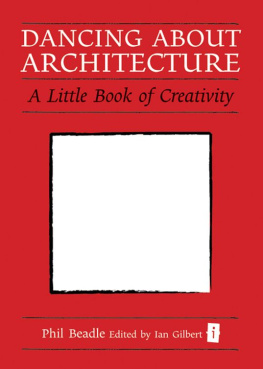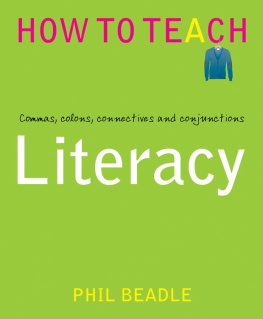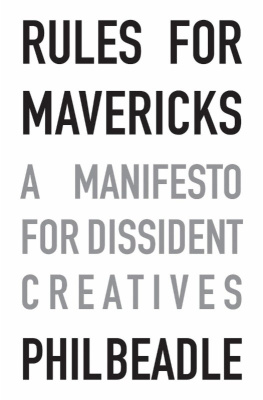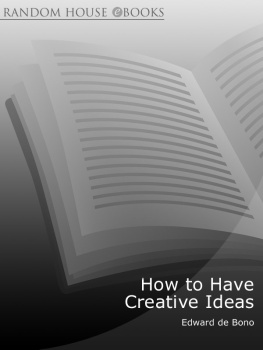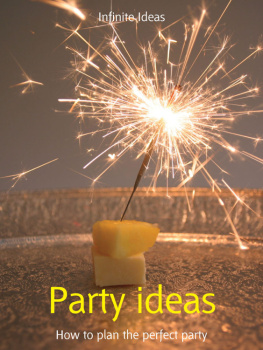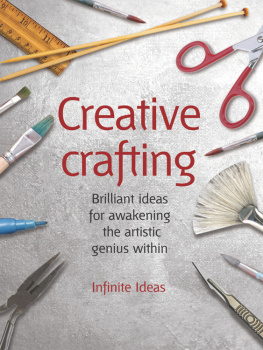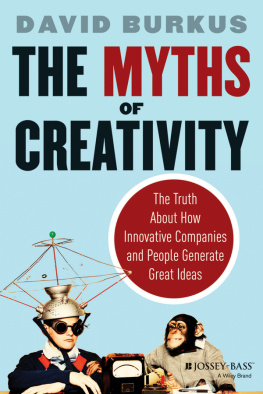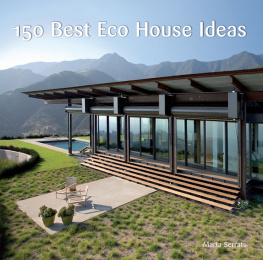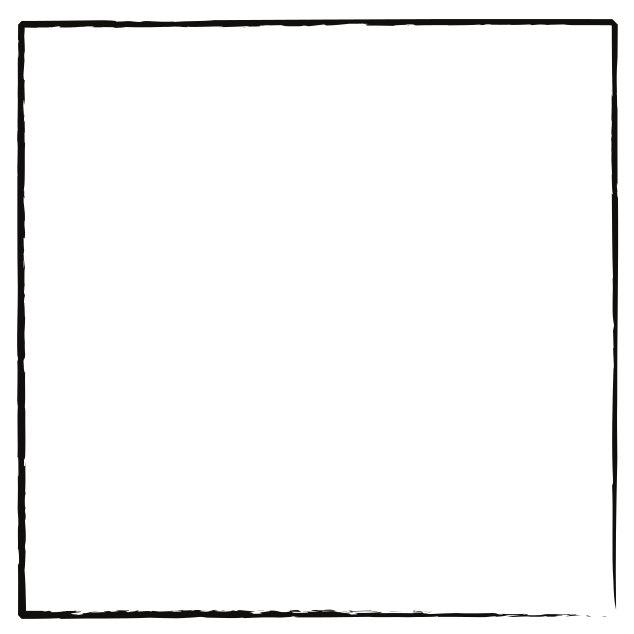Praise for Dancing About Architecture
I remember saying a few years ago that in order for education to become relevant to our students, we would need to work hard to turn it into the new rock n roll! Well, Phil Beadle may well be the lead guitarist of this new super group. Here is a book about teaching, and more importantly, learning, that is cool, irreverent and entertaining ! From the reference to Frank Zappa in Chapter One, I knew this book was pure Phil Beadle. Buy it, read it and get ready to rock out!
Richard Gerver
Educational commentator, author and broadcaster
Phil Beadles new book, Dancing About Architecture, is a well thought through testament to the power of creativity and the arts in education. Drawing on artists thinking across disciplines, Phil explores how connecting seemingly disparate ideas results in work that can astound, inform and surprise. He encourages the educator to focus on process, not outcome, in much the same way that an artist focuses on process. This inevitably means taking risks if the process becomes the focus, then risk taking becomes something joyful and, ironically, risk free what does it matter if tangents happen when the outcome is not primary or set in stone?
Any educator that tries out the very practical and applicable ideas and resources in this accessible, and concise book will find themselves part of a journey of discovery with their students; theyll become a part of the process in a different, more immediate way; and even more pertinently , theyll get to experience the joy of creative thinking and practice and the endless possibilities it throws up. Phil respects and acknowledges the teacher as an intelligent, talented, creative individual and offers them the possibility of reclaiming the classroom as a place of possibility, more effective learning and exploration, free of the anxiety of the Ofsted inspection, that most bogus of pantomimes.
The kind of practice outlined in Dancing About Architecture means the whole student is engaged, mind and body. This is learning theyll retain because it engages all of them in unexpected and playful ways. The rigid hierarchy of what subjects matter and the sheer aridity of sit-behind- a-desk -and-do-a-worksheet thats been set up by hundreds of years of academic hegemony is thrown into sharp relief as the nonsense that it is in this book. We were, as Phil points out, not evolved to sit behind a desk and do a worksheet. Personally, I cant think of anything more dreary.
The practice outlined in Dancing About Architecture is, ultimately , common sense. This book kicks the desks over, opens the windows and lets learning in it invites us to live life in a more joyful, human way. You wont regret giving it a go. Equally, anyone who is interested in the possibilities of how their child can be educated or in creative thinking, and especially those in the arts and especially those who happen teach in the arts, whether thats in a school or like myself, in an arts setting should give this a read. Ive learnt a thing or two, and Ive been working and teaching in the arts all of my adult life. In short, I highly recommend this book its a guide to the bright future of education.
Mhairi Grealis
Course Director, The Richmond Theatre
Creative Learning Co-ordinator, Music4children
Phil Beadle has not only written an excellent book he has designed a masterpiece for creativity-led education. Let this be your bible of learning theory and practice. I predict Beadles next book will be a collection of examples from people like you teachers, parents, policy makers, change managers, innovation specialists, volunteers about how the ideas and practical tools in Dancing About Architecture have transformed your thinking about education , producing results worth shouting and writing about. Dont miss Beadles invitation to dance your fitness in all matters educational is guaranteed to improve towards athletic proportions. Dont ignore this building block for the future of education. It contains the blueprint for architecting hours of fun in the classroom as well as serious learning results. Where Sir Ken Robinson tells us what to do in education, Beadle show us how to do it.
Kwela Sabine Hermanns, Innovation Specialist
This book is dedicated to my wife,
Jennifer Eirlys Marie Owens
Creativity is like pornography. Its hard to define but you know what it is when you see it. And it can get you into a lot of trouble bringing it into school. Like mobile phones.
Speak to many people, so-called experts, and read their books on creativity and you have the idea that the creative process is a world of rainbows, visualisation and tantric breathing. If the mention of the phrase creativity in the classroom has you reaching for the sugar paper and Berols then you are missing a trick. Its not that youre wrong. You can be highly creative with a paper and pens. Look at Rolf Harris (who I have said elsewhere is a multiply-intelligent god amongst men). But there is a rougher, edgier, more controversial, more two fingers in-your -face, stick-it-to-the-man creativity that sometimes sits uneasily in our middle-class, middle England teacher-training world. And Ive taught creativity to lifers in a maximum security prison so I feel I have a little authority here.
Every act of creation,' Picasso said, starts with an act of destruction.'
Creativity means you have to make a bit of a mess. What, then, might you have to break to move things forward creatively in your classroom? In your school? In your life? If creativity is about breaking the rules (which is different from having no rules. Very different) what is it that you have to rip up and start again to make things better? Even if it is working fine currently? And are you prepared to do it? Wed get into trouble for a starting a revolution ! as one lady told me at a school a while back. Thats the trouble with revolutions. They mess with your diary.
And are you equipped to do it? As you already know, our state education system was designed to get people not to think for themselves. Four Rs, not three. Reading, writing , rithmatic and respect for those above you. Teachers, social betters, bosses, generals, royalty, God. They will let you know what to think, should it ever be required. Thats what the Daily Mail is for.
Picasso doesnt tell you how to be creative though. Just how it starts. Breaking the rules doesnt guarantee creativity . Its just a prerequisite. If thats the case, where do those darned elusive ideas come from? Just how do you get old ideas out and new ones in.
Well, according to Dee Hock, the man behind the worlds first trillion-dollar company, VISA, the starting point isnt so much about learning but about forgetting.
Clean out a corner of your mind and creativity will instantly fill it.
Nature abhors a vacuum and the same applies in your head. The trouble is, if theres nothing to replace the gap left behind when you clear out all your old rubbish then some new rubbish will come along to fill it. Like ITV 2. So, where do the new ideas come from to fill the void left by eliminating your old ones? This question of the derivation of ideas was one that was approached by an advertising man called James Webb Young in 1939. His short book, A Technique for Producing Ideas, became the seminal book on how to get ideas, good ones, into your head. (And having also been an advertising copywriter I understand his compunction.) Webb Young suggests the following five-step plan to generating great ideas:
Step One Gather the raw material
Step Two Digest the material
Step Three Dont think

